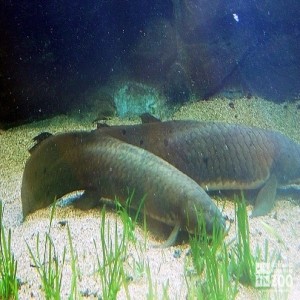Australian Lungfish
[Neoceratodus forsteri]

The Australian Lungfish grows to a length of 5 feet, and can weigh more than 20 pounds. It has large scales and lobed, paired fins fringed with rays retaining the primitive characteristic of being more numerous than the supporting bones. The dorsal, caudal and anal fins are confluent (run together). It is the most primitive of all lungfish. It has only one lung, and possesses functional gills. While the African lungfish can live for up to 4 years out of water, the Australian variety can exist for only a short time in atmospheric air. The gills are normally used for respiration, but atmospheric air can be breathed in adverse conditions. The teeth consist of a pair of sharp plates in each jaw which work in a shearing action.
Location: AE
Share:
Range
Australian lungfish are found in Australia.
Habitat
Australian lungfish can be found in rivers in Queensland.
Conservation Status
EndangeredPrimary Threats
Gestation
3-4 weeks
Litter
50-100 eggs in a clutch
Behavior
Lungfish are carnivores, and when fully grown will eat frogs and small fish.
Reproduction
The Australian lungfish does not estivate in a mud tube or chamber like other lungfishes. Reproduction has been observed in shallow water in August. Although native to two small river systems, stocks have been transplanted into other Australian rivers. At least three of these introductions have been successful, and fish have bred.
Wild Diet
Fish, amphibians
